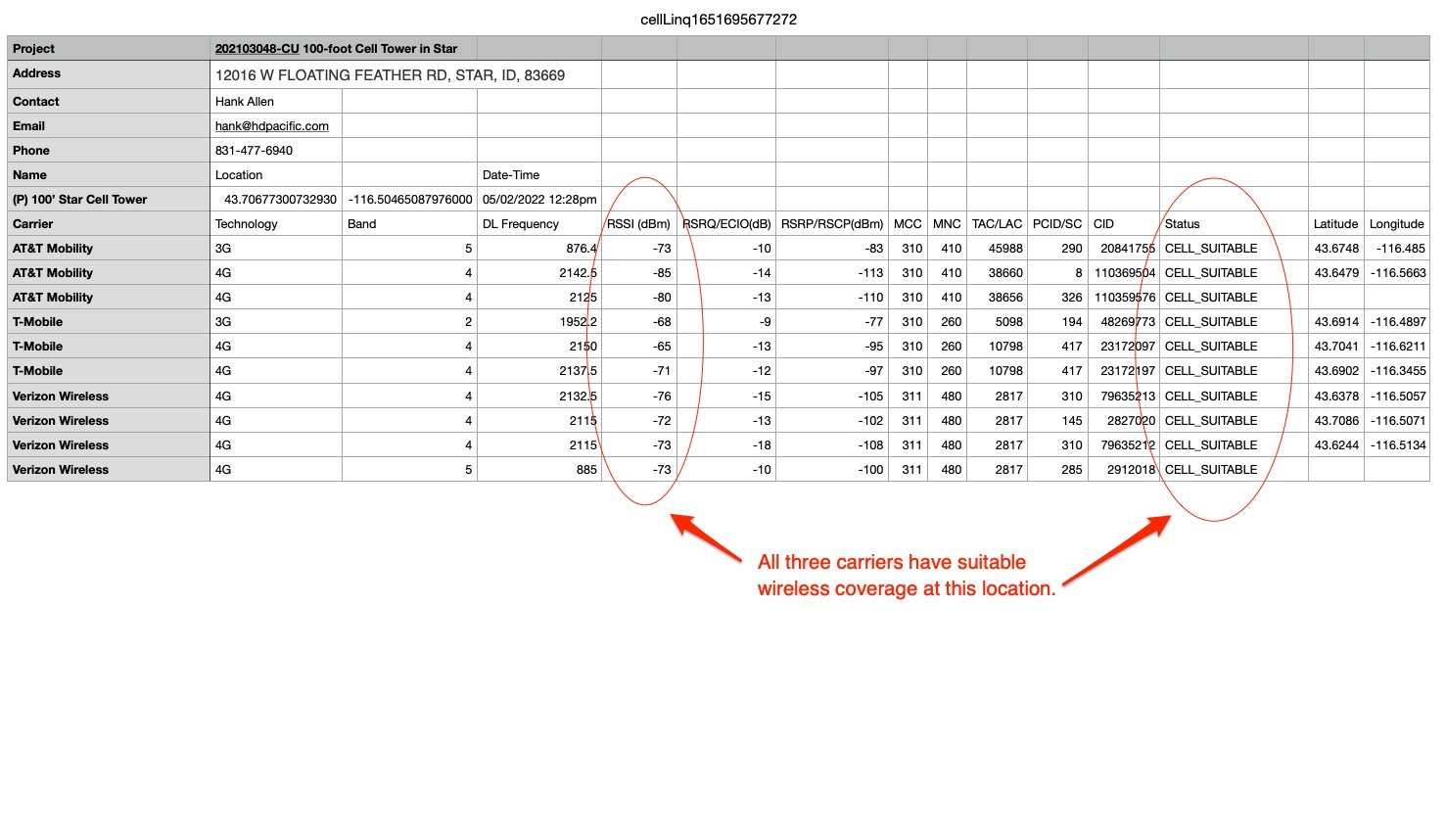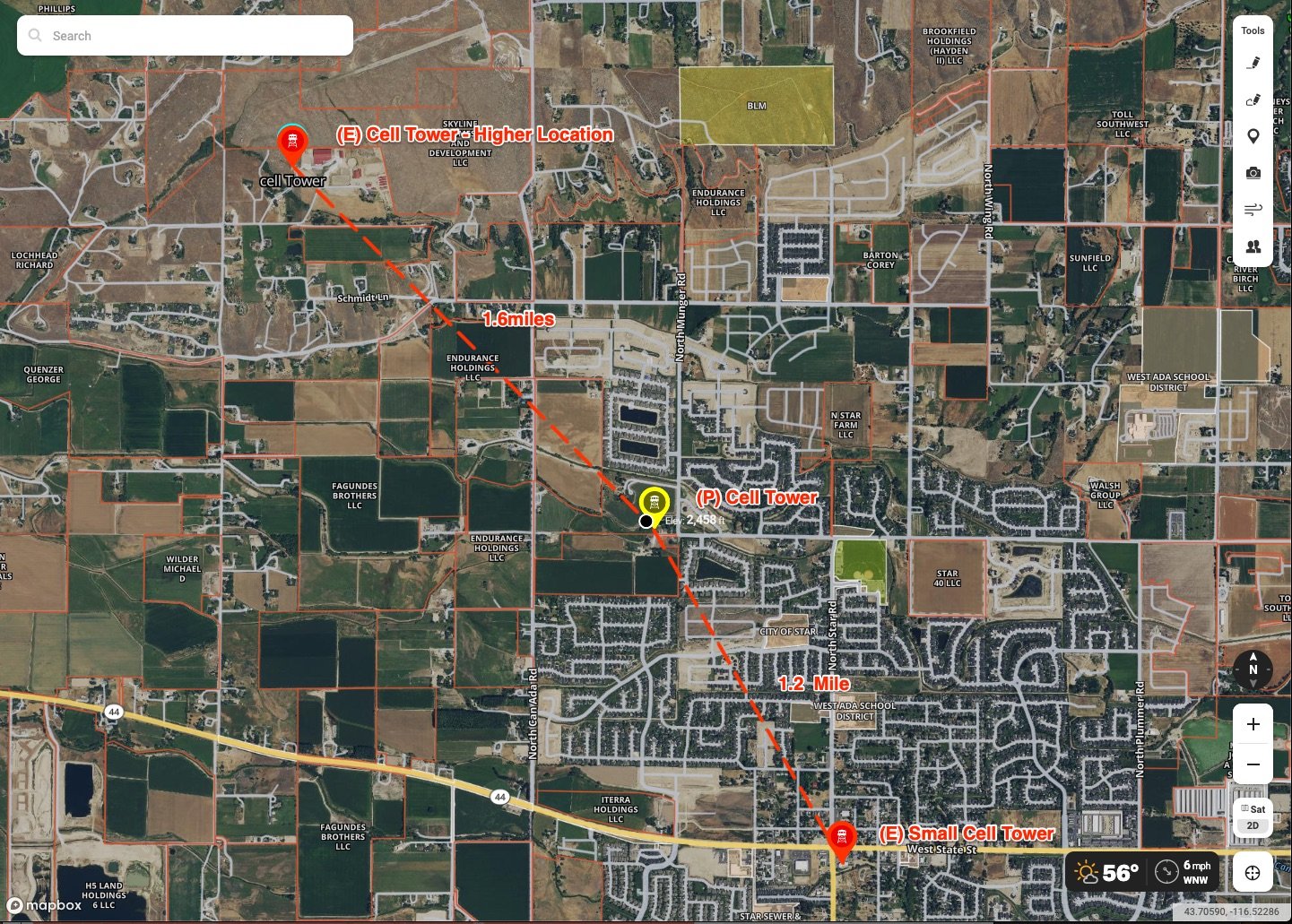Ada County Commissioners Unanimously Agree to DENY 100′ Cell Tower application in Star Idaho!
Update: August 10, 2022 – Success for the Second Time! Ada County Commissioners Uphold their May 11th decision to Deny a 100′ Cell Tower in Star, Idaho.
The Board found that the cell tower applicant did not demonstrate in enough detail why the proposed facility cannot be accommodated on an existing tower which was identified approximately 1.65 miles from the subject property. In addition, the applicant failed to demonstrate a significant gap in coverage exists in the area which would necessitate the proposed facility. See page 5 and 6 of the below Findings of Fact.
Here’s the video from the August 10th, 2022 Public Hearing to Reconsider the Boards May 11th, 2022 decision.
The Cell Tower hearing Starts at (time stamp 46:30)
Commissioner Questions and Ruling (time stamp 1:51:40)
The cell tower applicants have appealed the Commissioners May 11th decision and Ada County has agreed to hear their appeal.
The appeal will be on August 10th, 2022 @ 6:00 pm at the Ada County Courthouse in Boise. We are encouraging all neighbors to attend.
On May 11, 2022, Ada County Commissioners Unanimously Agreed to DENY a 100-foot Cell Tower application in Star, Idaho!
Start of Cell Tower Hearing (Timestamp 2:46:24)
Time Stamp of Highlights from the Hearing
Start of Cell Tower Hearing (Timestamp 2:46:24)
William Lind – Appellant (Timestamp 2:56:29)
Questions from Commissioners- Must Watch! (Timestamp 3:03:16)
Dave DeHass, IFST (Timestamp 3:05:38)
Attorney for Cell Tower Installer (Timestamp 3:11:07)
Lie #1 – No Existing Towers in 2 Miles (Timestamp 3:12:04)
Lie #2 Twisting the County’s co-locate code (Timestamp 3:12:09)
Lie #3 Distance to Existing Towers (Timestamp 3:15:22)
Lie #4 Alternate Site (Timestamp 3:15:52)
Lie #5 In Building Coverage (Timestamp 3:19:02)
Lie #6 Coverage Maps on our Site (Timestamp 3:21:52)
Vivian Lockary, IFST – Need for a Propagation Study (Timestamp 3:39:47)
Chad, RF Engineer from Rigby, ID – Coverage Map Lie (Timestamp 3:49:22)
Hank Allen, IFST – RF Site Survey and co-location alternate tower (Timestamp 3:53:17)
Cathy Cooke, IFST (Timestamp 3:58:28)
David DeHaas, IFST – Closing (Timestamp 4:07:50)
Commissioner Ruling in Favor of the Appeal! (Timestamp 4:09:40)
Written Public Testimony
05/04/22 – Request for CUP Denial and Appeal approval
On behalf of Idahoans for Safe Technology Foundation, Inc, we are requesting that ADA County Commissioners deny this conditional use application and approve the appeal based on the following:
Project Description: 202103048-CU – 12016 W. Floating Feather Rd., Star, ID. 83669 – Vertical Bridge, represented by the firm Clark Wardle, LLC, is proposing to place a 100-foot macro cell wireless facility for commercial use at this location.
There is no significant gap in wireless coverage at this location, therefore a tower is not needed.
Site cell coverage “Site Survey” shows suitable service coverage at the proposed location.
The site survey was performed using a $600 Wilson Pro (Cell LinQ) meter. Every town should own one!
Purchase a WilsonPro (Cell LinQ) Cellular Signal Meter Tool Kit – 910055. $600
What is Good Signal Strength for a Cell Phone?
The strength of a cellular signal can be accurately measured using decibel milliwatts, or dBms. Signal strength in dBms is expressed as a negative number and typically falls into a range that spans from -30 dBm to -110 dBm, with numbers closer to zero expressing stronger cellular signals. Essentially, this means that -77 dBm is a stronger signal than -86 dBm.
Signals better than -85 decibels are considered usable and strong, and you’ll rarely see a signal stronger than -50 dBm. At the other end of the spectrum, a signal that’s weaker than -100 dBm is likely too problematic to be useful — resulting in dropped calls and incomplete data transmissions.
05/02/2222 – Site Survey
There is an existing cell tower located 1.6 miles to the North-West that is in a superior raised foothill location away from homes and schools. Co-Locate providers here would be the smart choice.
Coverage Maps from Three Leading “Wireless” Carriers
Verizon 5G Coverage
T-Mobile 5G Coverage
AT&T 5G Coverage
All three carriers offer basic voice “Telecommunication services” to this location. There is No significant gap in Title II coverage, therefore there is no need for an additional wireless cell tower!
Find carriers coverage maps at Verizon, T-mobile & AT&T.com.
Existing “Wired” Broadband Providers and Coverage Map
This location already offers superior wired DSL, Cable, or Fiberoptic wired broadband capacity, there is no need for additional 4G or 5G wireless broadband.
Find broadband services providers at BroadbandNow.com.
Summary for Denial
All three leading wireless carriers have sufficient towers and infrastructure in place to provide basic phone and texting “Telecommunications Service” to this location with no significant gap in coverage. In addition, this location is already hardwired for superior broadband “Information Services”. Therefore an additional tower is NOT need at this location unless the applicant can prove that this tower will be providing Title II services. Application Denied
The Law
Local Government has the Authority and Responsibility to Regulate Personal Wireless Facilities (see below)
“Title I” / Broadband / 5G/ Information Services are Not Regulated by the 1996 Telecommunications Act!
Mozilla et al. v FCC – Quoting from Judge Millett’s Ruling in Case No. 18-1051.
” The 1996 Telecommunications Act creates two classifications for broadband Internet: ‘telecommunications services’ under Title II of the Act and ‘information services’ under Title I.
Title II [telecommunications service] entails common carrier status, see 47 U.S.C. § 153(51) (defining “telecommunications carrier”), and triggers an array of statutory restrictions and requirements
Title I “information services” are exempted from common carriage status and, hence, Title II regulation.
The judge’s discussion then continues onto mobile service, showing that the FCC’s Restoring Internet Freedom Order, 33 FCC Rcd. 311 (“2018 Order”) classified broadband Internet as an “information service,” see 2018 Order ¶¶ 26–64, and mobile broadband as a “private mobile service,” see id. ¶¶ 65–85 . . . therefore the only wireless service that remains as regulated Title II is wireless phone call service.
Telecommunications Act of 1996 (1996-TCA) . . . also known as Section 704 from Senate Bill 652,
47 USC § 332(a)(7)(A)
General authority. — Except as provided in this paragraph, nothing in this Act shall limit or affect the authority of a State or local government or instrumentality thereof over decisions regarding the placement, construction, and modification of personal wireless service facilities.
47 USC § 332(a)(7)(B)
(i) The regulation of the placement, construction, and modification of personal wireless service facilities by any State or local government shall not prohibit
functionally equivalent services
personal wireless services
(ii) State or local government shall act on any request for place, construct, or modify personal wireless service facilities within a reasonable period of time
(iii) Decision by a State or local government to deny a request to place, construct, or modify personal wireless service facilities shall be in writing and supported by substantial evidence contained in a written record.
(iv) No State or local government may regulate the placement, construction, and modification of personal wireless service facilities on the basis of the environmental effects of radio frequency emissions
(v) Any person adversely affected by any final action or failure to act by a State or local government or any instrumentality thereof that is inconsistent with this subparagraph may, within 30 days after such action or failure to act, commence an action in any court of competent jurisdiction. The court shall hear and decide such action on an expedited basis. Any person adversely affected by an act or failure to act by a State or local government or any instrumentality thereof that is inconsistent with clause (iv) may petition the Commission for relief.
Additional evidence that was added to the public record:
These two document contain the latest and best information regarding scientific evidence of harm from Cell Tower RF radiation. Do not discuss HEALTH EFFECTS IN THE PUBLIC HEARINGS! Just add it to the public record.
(iv) No State or local government may regulate the placement, construction, and modification of personal wireless service facilities on the basis of the environmental effects of radio frequency emissions
End of Appeal
Past Cell Tower Case Information To Learn From
ADA County – Eagle Cell Tower Case Information from 2019
ADA County Commissioner Rick Visser outline the LUPA and Idaho State law in the 2019 cell tower denial (listen to the audio recording below). This case was lost because ADA County did not challenge the bogus computer generated propagation study provided by an out of state RF engineer at the Horizon Tower vs Ada County hearing, so the judge issued a consent judgment order in favor of Horizon. See pages 3 & 4 of the Consent Judgement Order. It’s also important to note that no costs and/or attorney’s fees where sought or awarded to any party (See page 6).
2557 N Sky View Ln., Eagle – Cell Tower CUP denial from ADA County Commissioners.
ADA County Commissioner Ruling – Jan 30th, 2009
201801311-A; EBERLE BERLIN; An appeal of the Planning & Zoning Commission’s decision to approve a conditional use application to construct a 65 foot commercial cell tower (height 73 feet with lightning rod) and an antenna structure with associated equipment storage in a fenced lease area. The property contains 5.00 acres and is located at 2557 N. Sky View Lane in Section 5, T. 4N, R. 1E. (Tabled from 01/09/19)
ACTION:
R. VISSER MOVED TO APPROVE APPEAL APPLICATION NO. 201801311-A (EBERLE BERLIN APPEAL); AND OVERTURN THE PLANNING AND ZONING COMMISSION’S DECISION TO GRANT THE CONDITIONAL USE PERMIT FOR CONSTRUCTION OF A 65 FOOT CELL PHONE TOWER; DIRECT STAFF TO PREPARE FINDINGS OF FACT AND CONCLUSIONS OF LAW CONSISTENT WITH OUR DECISION BASED UPON THE SUBSTANTIAL RECORD, AND THE TESTIMONY PRESENTED TONIGHT; AND TABLE THE MATTER TO FEBRUARY 6, 2019, TO ADOPT THE REVISED FINDINGS OF FACT AND CONCLUSION OF LAW. D. LACHIONDO SECONDED. R. VISSER, AYE, D. LACHIONDO, AYE, AND K. KENDRA, AYE. THE MOTION CARRIED UNANIMOUSLY.
Horizon Tower vs Ada County
This is a link to the Consent Order for Ada County to issue the Cell Tower permit to Horizon Tower. No RF Engineer was provided by Ada County to dispute Horizons’s gap in coverage claim. There was ample cell coverage, yet no professional engineer to provide countervailing evidence. Here’s your evidence!
Consent Order & Judgment – Horizon Tower vs Ada County
Learn From The Best
Leading cell tower attorney Andrew Campanelli and local Attorney Norman Semanko fight cell tower in Boise County, ID (May 2022). This is a great video to learn and understand the Federal Law. (Timestamps below)
Local Attorney Norm Semanko makes opening presentation to Boise County, ID Commissioners.
Timestamp: 0:00:00
Andrew Campanelli – Cell Tower Presentation to Boise County, ID
Timestamp: 00:01:58
Andrew Campanelli – Rebuttal and Final Closing to Commissioners
Timestamp: 02:32:00






